Expedition Cycling: A How-to Primer
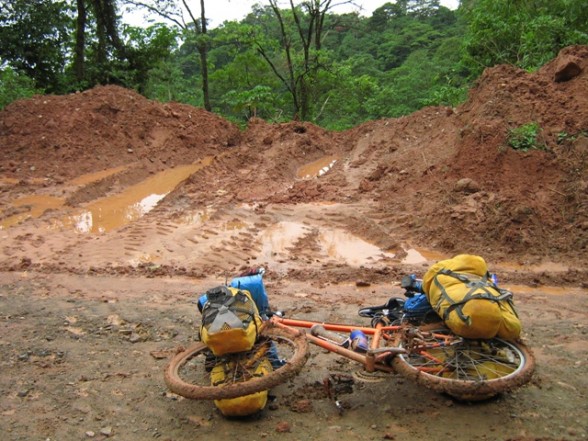
Mud splattered up my black nylon rain pants as I pedaled down the rocky, wet road from Huancane along the northern route of Lake Titicaca. My bright orange panniers from Arkel Overdesigns were muddied and battered from a rough fall, but they’re the kind of bags that can take a blow from a speeding truck and still look brand new. Unfortunately, my beefy JANDD expedition racks were bent out of shape and I had to secure them to my bike with a piece of rope to prevent them from falling off. As I slowly headed for La Paz, Boliva along the infamous “contraband route” I realized that this was “Expedition Cycling” at it’s finest!
Expedition Cycling is similar to traditional bicycle touring, with one fundamental difference – most of your cycling takes place on roads that are unpaved, unmarked, not on the maps, and often in uninhabited zones. It’s a dangerous and risky way to travel. If you’re injured or killed, there is a good chance no will even know! Naturally, with dangers of this type, you want equipment that is rugged, dependable, repairable and (should you lose anything) replaceable.
Here are the some of the items you need in order to taken you very own Expedition Cycling adventure:
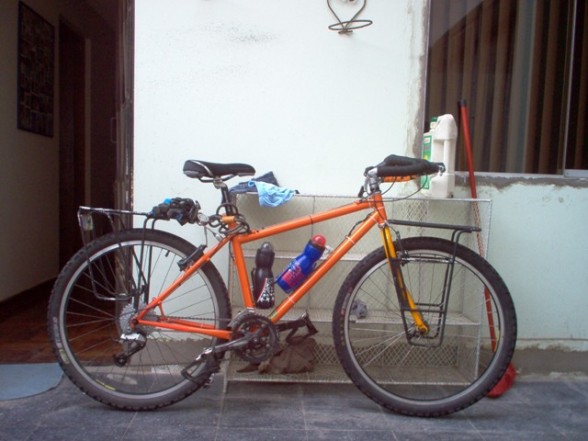
The Bicycle
Obviously, Expedition Cycling isn’t possible without a good, quality bike. For this kind of a trip, forget about traditional road bikes with 700 cc wheels. Stick with a mountain bike instead! The last thing you need to happen in a back country environment is to have a bad spill and get your rims or frame bent out of shape. Mountain bike rims are recommended as they have the thickness needed to deal with almost any bad bump, fall, or crash. The frame of your bike should also be designed to take some abuse. On this kind of trip, you are going to beat the $h!t out of your bicycle and that means that you need a frame a rims that you can BEAT THE $h!t out of as well.
Some traditional touring bike manufacturers make frames that take 26 inch mountain bike wheels. But, if you’re ever in doubt, stick with a mountain bike frame.
When choosing a bike, I don’t recommend purchasing a pre-packaged bicycle (i.e. one that’s already fully assembled). Because of the unpredictable nature of Expedition Cycling, knowing your equipment, how it works, how to repair it, and how to maintain it can mean the difference between a joyous ride and a painful one.
For me, that meant purchasing a separate frame made of solid 4120 or Reynold’s steel tubing with strong drop outs and tough welds. My bike frame came from Bike Nashbar and is composed of Reynolds for the triangle and 4120 for the dropouts. Sometimes the frame doesn’t come with braze ons for the racks. I had a set welded on at Bilenky bicycle works in Philadelphia. Other excellent steel mountain bike frame makers that I recommend include Soma, Salsa, and Surly. I chose steel because in the areas where I’m traveling, it’s impossible to find anyone who can weld aluminum. Steel is readily available almost anywhere in the world and it’s easy to fix. Stick with it!
While you’re at it, ally yourself with a good bike shop and have them inspect your bicycle properly and give it a once over. When you take off on a trip like this, it is important to have the experts inspect your bike for potential problems that you yourself might not be able to see.
For components, Shimano LX is the gold standard. It’s tough, and unlike XT or XTR, which are made of lighter materials for racing, LX has the strength and robustness to withstand wear and impacts. LX cassettes, chains, bottom brackets, derailleurs, hubs, and brakes must be part of your bike. Choosing good components, again, makes a huge difference when you are trying to go up a dirt hill with 100 pounds of food, water, and gear on your bike. Don’t skimp on the components!
To reduce the number of mechanical problems you experience, don’t use shocks on your front or rear forks. The bags, when full, will absorb the majority of the shocks you receive from riding on rough roads.=.
For handlebars, I’ve become a big fan of the moustache bar. When I took my first trip in 2001, the straight bar with bar extensions only offered me two hand positions, both of which resulted in injured nerves inside of my palms. The moustache bar offers several hand positions, which alleviates any prolonged stress on the hands. In addition, the moustache bar offers one other advantage for expedition touring, which is the use of bar end shifters. Bar end shifters have the option of index shifting and friction shifting. Should anything happen to the index guides, a quick turn of the key permits friction shifting. Mis-shifts, due to the
wear and tear of the chain and cassette will happen, and unlike thumb shifters, the switch to friction shifting will save you many headaches out in the wild.
Brake levers for V-brakes are the next consideration. Almost any road brake lever should do the job when used on the moustache bar with V-brakes.
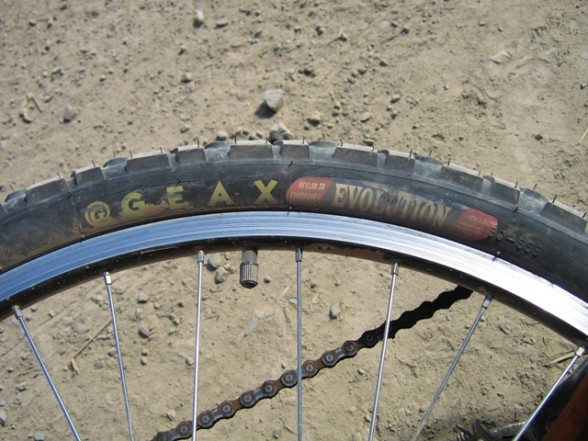
For treads, I swear by the GEAX dual terrain tires. These tires are made of a kevlar compound and the GEAX Evolution tires have, for me at least, lasted several thousand miles in South and Central America. They’re good for both on-road and off-road terrain, and they are extremely durable.
Once you’ve assembled the major pieces for your bike, it’s time to put it all together. I recommend assembling your bike by yourself. This exercise of assembling your own bike will familiarize you with your components, essential tools, and how everything works. You will need that knowledge when (not “if”) something breaks down while you are out on the road.
The Bags and Racks
There are two options for carrying your gear – a trailer or panniers. Getting into which is better often turns into a religious war, so, to put my opinion into the fray, I’ll state right now that I am a pannier man. I’m not a fan of big, heavy equipment, and a trailer counts as yet another large item I have to lug around. So, if you’re looking for the advantages of the trailer article, don’t look here. I’m a fan of keeping everything together as one tidy unit… and therefore I choose to travel with panniers.
For racks, JANDD expedition racks have served me well for the last seven years. They’re made of aircraft aluminum and they have mounting platforms on the top for carrying extra items. This is extremely important when properly balancing your bicycle, especially in off-road terrain. Mount points use commonly available screws, which is a lifesaver, because if you lose some, you can get a replacement in any back country town or village.
Bags
After picking out your bike, the second most important items you need for Expedition Travel are your bags (or “panniers”). Imagine your bicycle is a horse and you’re going into the wild west. Obviously you don’t want to bring overly-priced Gucci bags, or something snazzy, or anything poorly made. You want to go with bags that can endure the following (all of which I have experienced):
- Getting hit by a loaded logging truck at 30 miles an hour;
- Flying off your bike at 35mph;
- Slamming into the dust, gravel, mud, slime, cow manure, horse manure, lama manure, lake water, cactus spines, etc.
- Thrown into old developing world bus racks with a crate of dead chickens on top
- Tossed into a luggage compartment with rotting cow parts dripping on it.
On top of all this, your bike and bags need to be narrow enough to fit through doors when still fully loaded, the bags have to attach properly to your racks, and they need to be capable of carrying a lot of gear, food and water. To handle this task, I chose to use Akrel panniers for my Expedition Cycling adventures.

To say that the Akrel bags are overdesigned is an understatement. I’ve come to the opinion that these bags were designed for survival during a nuclear blast. That’s how tough these bags are. I’ve seen and experimented with other bags, but none have EVER come as close to form, functionality, and pound the $h!t out of em as Arkel Overdesigns. These bags are truly designed for punishment that only a masochist could love. The best part is, whenever you’re in town for more than a few days to rest, recuperate, and repair, just soak them in laundry detergent, rinse twise, and they’ll look almost new.
Essentials

Expedition touring is a lot like backwoods camping, with the exception that you’ve got a bicycle and repair equipment. Here’s the general list of what I carry when traveling with my bike. This list is specific to my needs and requirements, so your gear selection will vary.
Clothes
- 4 pairs of underwear
- 4 pairs of socks
- 2 undershirts
- 1 long sleeve button up shirt
- 1 set of silk/polypropylene long underwear
- 3 pairs of bike shorts, 2 short, and 1 long
- 2 bike shirts
- 1 pair of bike arm sleeves
- 1 short sleeved collared shirt
- 1 pair of short finger gloves
- 1 pair of long finger gloves
- 1 pair of water proof pants
- 1 wind breaker, water resistant and stuffable
- 1 stuffable inner liner cold weather jacket, synthetic
- 1 baseball cap hood combination (Columbia designs hat) – looks like a Lawrence of Arabia hat
- 1 medium sized towel
- 1 face towel
- 1 bandanna
- 1 tie
- 1 pair of dress pants
- 1 formal dress shirt
- 1 pair of khaki pants (no jeans!)
- 1 balaclava
- 1 pair of sandals
- 1 pair of boots
- 1 wool sweater
Miscellaneous Items
- 1 journal book, pen, pencil, colored pencils, with pencil sharpener
- 1 pad of airplane paper and envelopes
- 1 compact film/digital camera with memory cards, computer cable, batteries and charger
- 1 SLR/digital camera and film
- 1 LED headlamp
- 1 back up flashlight
- 2 boxes of matches, 3 candles
- 1 dagger/survival knife with sheath
- 1 machete
- 1 leatherman? tool with sheath
- 4 bungee cords, 2 long, 2 short
- first aid kit with spare medicines, including the basics of ciproflaxin, metrodizole, and mylanta, all of which you can get without a need for a prescription in latin america
- 1 compass
- 1 bug repellent spray
- 1 bug killer spray
- MSR firefly gas cannister stove, and 3 gas cans (get the gas cans in Latin America, don? carry them on the plane)
- pot with utensils (mess kit), and a fruit peeler
- 1 head net
- spare pair of glasses with case
- 1 water filter, I use a Katadyn hiker pro
- 1 set of motorcycle goggles
- 1 iodine water treatment set
- 1 money belt or neck pouch
- 1 3/4 season 0 degree sleeping bag (polarguard filler preferred) with compression stuff sack
- 1 z rest pad
- 1 tent (Eureka Zephyr II)
- 1 roll of toilet paper
- 1 toilet kit (toothbrush, dental floss, paste, razor, shaving mirror with a porn star on the back, nail clippers, zit picker, tweezers, nose hair clippers, and soap)
- 2 nalgene bottles with duct tape wrapped around them
- 36 lubed condoms with spermicide. Lifestyles are my favorite, with Trojans taking second. I love the value packs. Do not buy these with your friend in the super market while picking up 10 pounds of bananas that your mom wants to prepare for a picnic. That just looks bad at the cash register.
- 1 deck of handwriting analysis cards

Tools and parts for the bicycle
- 1 combo hex and screw driver wrench kit
- 1 multi tool
- 1 pedal wrench
- 1 crescent wrench
- 1 piece of spare chain, 10 links
- 1 set of spanner wrenches
- 4 spare brakes
- 1 spare inner tube
- 1 spare kevlar tread
- 1 patch kit with extra patches
- 1 long kryptonite cable with separate combination lock
- spare rack parts and nuts
- 1 old toothbrush
- 1 bike pump with duct tape wrapped around it
- 1 helmet
- 1 red blinker
- 1 bicycle computer
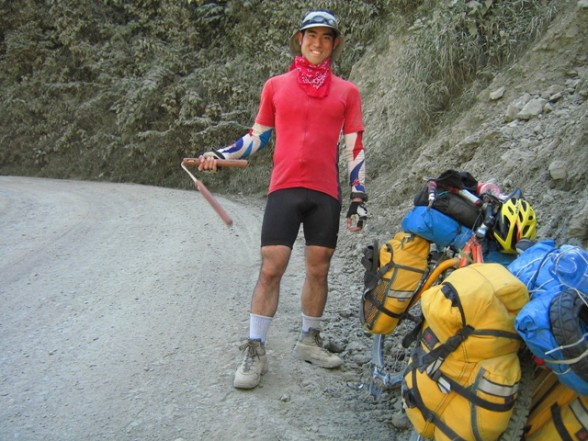
Extras
- 1 small internal frame backpack that can be used for trips up to 5-6 days (for side trips and expeditions)
- 1 courier day bag
- 1 camcorder with batteries, 10 tapes, charger, and cables to connect to the TV
- 1 tripod
- 1 cell phone and charger
- 1 set of practice nunchakus
- 1 set of real nunchakus. (***NOTE: I consider personal self defense extremely important when doing this sort of activity. Laws vary per country regarding a variety of personal defense weapons, so you
either comply with the laws, make do, improvise, or smuggle. I listed the machete as part of my kit, and that alone makes for a formidable defense weapon, as well as an excellent all around tool for excursions. I know some people are squeamish about this, but if you seriously take on what I do, then it’s something that you MUST consider. ***) - 1 mp3 CD player, headphones and batteries. I do not use an ipod, or
any other massive mp3 storage device because the conditions I go through
will trash the hard drive permanently. A CD player is far more robust,
and in changing countries and conditions, flexible. - 1 40 CD booklet
- spanish-english dictionary
- portugese-english dictionary
- The Elements of Style, by Strunk and White
- The Dream Dictionary
- El libro de los formulas para ciencia y ingeneria
- Zen and the Art of Motorcycle Maintenance
- Marte 2056
- 1 booklet on nunchaku technique, attack and defense theory
- 1 folder with notepads and documents
It looks like a lot, but I’ve carried all of the above for months, even a year during my last expedition. And there is still some extra room for food! Usually, I carry the following as my standard 2-3 day rations through the mountains or rain forest.
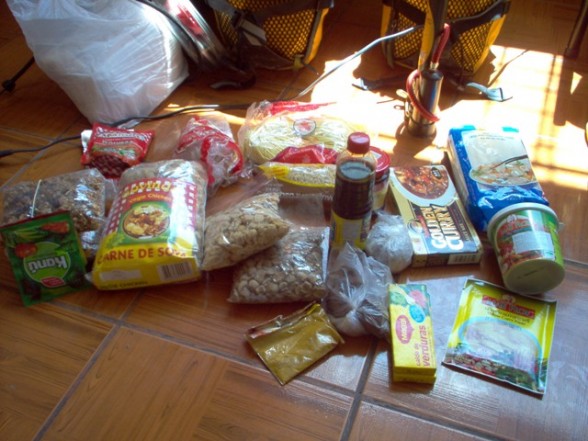
Food
- 1 pound of rice
- 1 pound of lentils
- 5 bags of noodles, or 1 large bag
- 6 packets of powdered juice mix
- salt and sugar
- powdered milk
- powdered hot chocolate, nestle, or nutritioncal drink mix
- 1 pound of oats
- 5-6 liters of water
- vegetable boullion packets
- sushi seaweed paper
- 1 small bottle of rice vinegar for sushi (Hey, I gotta have some
luxuries)
My Final Piece Of Advice: On a trip like the one I’m taking, you have to be ready for just about anything that can (and will) go wrong.
David Nghiem recently released a book about his quest on a bicycle through Latin America, which you can purchase at Booklocker.com. More information about his trip can be found at Dave’s New Adventure

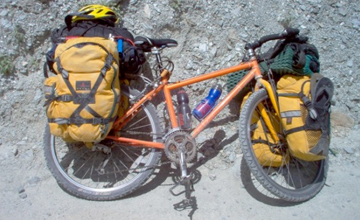
Very nice! This is exactly the type of trip I want to take some day.
LOL one can never have too many condoms!
Nice list David…Lots of stuff! I’d like to see some further reviews of some the brand/specific gear that performed great…as well as stuff that failed or stuff to stay away from. Real-life, long-term expeditions are always the ultimate test for gear, so would like to know more…
Do you really cary a big sawblade around? what do you use that for?
A really thorough look at touring, great list and great advice too.
Thanks
Great article Dave.
Also, great book. Both Lisa and I really enjoyed it. My shops in Southbridge, MA and Putnam, CT have already sold out of all 20 copies. Who would think there would be such strong interest in our little towns. Just shows that Bicycle Adventure Travel speaks to some deep inner need so many of us have, even if we do it vicariously through guys like you..
very well explained..